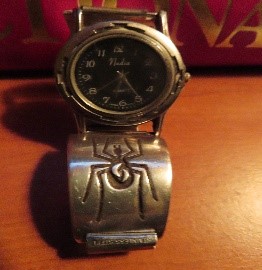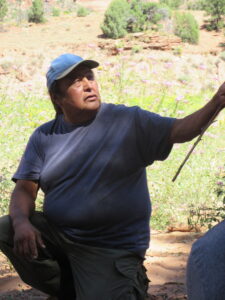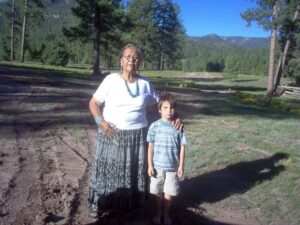May 15, 1992, Canyon de Chelly. It was my first time to be at the foot of Spider Rock on the canyon floor at the confluence of incredible energies.I was here with friends Ernesto, Doug and Fred and Dinè (Navajo) guide Daniel Staley.
Grandmother Spider or Spider Woman is a sacred being that is part of the creation story for many Indigenous people in the American Southwest. https://en.wikipedia.org/wiki/Spider_Grandmother (Note that there may not be qualified Indigenous sources for this website article.) I had a special relationship with the spider that went back to my days in graduate school at the University of Denver in 1971 when I met and fed yogurt to a little spider who visited my basement apartment. In my personal memoir, I have detailed magical encounters with spiders through the years, including a black widow who worked on her web in the shower stall every time I bathed at my home in Chupadero, north of Santa Fe, NM.  For many years I have worn a watch band made by Hopi artist Ross Joseyesva with a spider design that includes what he called the “friendship symbol.” Ross sent me the watch band in the mail before I had paid for it, which I consider an act of friendship and trust, much like that little spider accepting my offering of yogurt before she traveled on.
For many years I have worn a watch band made by Hopi artist Ross Joseyesva with a spider design that includes what he called the “friendship symbol.” Ross sent me the watch band in the mail before I had paid for it, which I consider an act of friendship and trust, much like that little spider accepting my offering of yogurt before she traveled on.
Daniel shared that there are many versions of the creation story, but if there ever is only one, it will mean the end of the world! Other cultural lessons from Daniel:
one, it will mean the end of the world! Other cultural lessons from Daniel:
- When gathering plants for use, always select from the east side.
- Likewise, choose a fire poker stick from east side of plant. The stick when not used is placed on top of house to protect it from burning.
- The Juniper tree has a beaded pattern from which the early people learned how to make baskets. Juniper bark was once used for diaper like material and to line infant cradles.
Dinè elder Annie Kahn had given me permission to bring folks to her home, so two days after the Canyon experience, my friends and I sat in her hogan as the full Wesak Moon set and sun rose. We were to record dreams for four nights, then put them away until the new moon, forgetting them until then and retrieving them to see what has transpired. Annie was a wonderful teacher, healer and storyteller. She shared a dawn prayer song which I have sung daily ever since, no matter where I am:
Hozho Ashado
I walk in Beauty, just for you and only you.
I talk in Beauty, just for you and only you.
I sing of Beauty, just for you and only you.
Annie Kahn Passes (2010)
Annie spoke of the “two spirits” or nadleehi and dilbaa persons born, respectively, as males or females–who U.S. general culture might call “gay.” This was my “tribe” of people and they were once a family responsible for changes and transitions in life Annie said. The relatives of this family contain elements of both worlds of up and down, night and day, male and female she added. Annie used the phrase “twice blessed” to refer to us. https://www.pbs.org/independentlens/documentaries/two-spirits/
We were given some self-care homework to practice at home: Breathe in the sun four times with arms taking in the horizon, allowing it to grow and be alive. Remember that there must always be a spirit line, a place of surprise and mystery in all of life and listen to the wind, allowing all our senses to be aware. Dinè people share a story, she said, but not all of it; it is up to each individual to add from their own experience. Above all, don’t stick to the normal, government inspected and approved path–explore, experiment, touch taste, smell, see hear for yourself. Let go of shame she advised, and use the parts of yourself that have been forgotten. Take in “the other” (you define that for yourself) with your left side and balance with the right.
On the day we left, we enjoyed a breakfast meal with tablecloth on the floor. Cornmeal mush was served in a woven basket, its “spirit line” to the East. We fed ourselves like children with our hands, not worrying about social etiquette, happily spilling some if we did, and at the same time feeding all other Beings.

